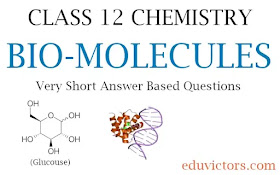Chapter 13 - Bio-Molecules - Very Short Answer Based Questions
CBSE Class 12 - Chemistry
Q1: What are carbohydrates?
Answer: Carbohydrates are optically active polyhydroxy aldehydes or ketones or the compounds which produce these on hydrolysis.
Q2: What are the two end products of cellular respiration?
Answer: CO₂ and H₂O
Q3: What are the four types of carbohydrates?
Answer: Monosaccharides, Disaccharides, Oligosaccharides and Polysaccharides
Q4: What are monosaccharides? Give two examples.
Answer: Monosaccharides are the carbohydrates which cannot be hydrolyzed further. e.g. glucose, fructose, ribose.
Q5: Name the two carbohydrates which act as biofuels.
Answer: Starch and glycogen.
Q6: What are disaccharides? Give two examples.
Answer: Disaccharides are those carbohydrates which produces two monosaccharides on hydrolysis. e.g., sucrose, maltose and lactose.
Q7: How many asymmetric carbon atoms are present in D (+) glucose?
Answer: Glucose, with six carbon atoms, has four asymmetric carbon atom.
Q8: What are oligosaccharides?
Answer: Those carbohydrates which give two to ten monosaccharides on hydrolysis are called as oligosaccharides. Oligosaccharides are a component of fibre from plant tissue.
Q9: Which polysaccharide is stored in liver of animal?
Answer: Glycogen
Q10: What are polysaccharides? Give examples.
Answer: Polysaccharides are those carbohydrates which on hydrolysis give large number of monosaccharides hydrolysis. E.g., starch, cellulose, glycogen.
Q11: What is glucouse?
Answer: Glucose is a monosaccharide with molecular formula C₆ H₁₂O₆.
Q12: What are sugars? Name its types.
Answer: Carbohydrates which are sweet in taste are called sugars. They are divided into reducing sugars and non-reducing sugars.
Q13(MCQ): Which of the following is a reducing sugar?
(a) Glycogen
(b) Maltose
(c) Sucrose
(d) Starch
Answer: (b) Maltose
Q14: What are reducing sugars? Give an example.
Answer: Reducing sugars are those carbohydrates which reduce Fehling’s or Tollen’s reagent due to availability of free aldehydic groups. e.g., glucose, fructose, galactose.
Q15: What are non-reducing sugars. Give example.
Answer: Non-reducing sugars are those which do not reduce Fehling’s or Tollen’s reagent. They do not have free aldehydic group. E.g., sucrose.
Q16: Give chemical name of Tollen’s reagent.
Answer: Ammoniacal silver nitrate solution.
Q17(MCQ): Which of the following disaccharide consists only of glucose unit?
(a) Sucrose
(b) Maltose
(c) Lactose
(d) All of these
Answer: (b) Maltose
Q18: What are anomers?
Answer: The two cyclic hemiacetal forms of glucose differ only in the configuration of the hydroxyl group at C1, called anomeric carbon Such isomers, i.e., α –form and β form, are called anomers.
Q19: How glucouse is prepared from sucrose?
Answer: Sucrose is boiled with dil. HCl or H₂SO₄ in alcoholic solution.
H⁺
C₁₂H₂₂O₁₁ + H₂O --------→ C₆H₁₂O₆ + C₆H₁₂O₆ (only from sucrose)
glucouse fructose
Q20: What is a Glycosidic linkage?
Answer: The linkage between two monosaccharide units through oxygen is called the glycosidic linkage.
Q21: What are proteins?
Answer: Proteins are macro molecules made up of amino acids joined by amide linkage [− (− CONH −) −] is here called as peptide linkage. These are required for growth and development of the body.
Q22: Are proteins natural or synthetic polymers?
Answer: Natural polymers.
Q23: What are amino acids?
Answer: Amino acids contain an amino (- NH₂) and an acidic (- COOH) group and are therefore amphoteric in nature. In solution they exist in the form of zwitter ion.
Q24: What is a Zwitter ion?
Answer: In aqueous solution, amino acids exist as a dipolar ion known as zwitter ion due to the presence of both acidic and basic group in the same molecule.
Q25: What are essential amino acids? Give two examples.
Answer: Essential amino acids cannot be synthesized in the body and must be obtained through diet, e.g. Valine, Leucine (a dipolar ion).
Q26: Are fibrous proteins soluble in water?
Answer: No
Q26: Give two examples of fibrous proteins.
Answer: Keratin (in hair, wool, silk) and myosin (present in muscles).
Q27: Give examples of globular proteins.
Answer: Insulin, thyroglobin, albumin, haemoglobin and fibrinogen.
Q28: What are enzymes? Give examples.
Answer: Enzymes are biocatalyst and generally globular proteins e.g., invertase, zymase, phenylalanine hydroxylase, urease etc.
Q29: How many amino acids occur in almost all protein?
Answer: 20.
Q30: Give an example of water soluble vitamin.
Answer: Vitamin C.
Q31: Name the amino acid which is not optically active.
Answer: Glycine.
Q32: What type of linkage holds together the monomers of DNA and RNA ?
Answer: Phosphodiester linkage.
☞See also:
How to learn naming Chemical Formulae
Four New Elements Added in Periodic Table
Solid State - Crystalline Solids vs Amorphous Solids
Chapter 2 - Solutions (Important Points)
Chapter 2 - Solutions (Very Short Q & A)
Chapter 3: Electrochemistry (Short Q & A)
Chapter 15: Polymers (Very Short Q & A)
Chemistry In Everyday Life (Very Short Q & A)
Functions of Catalysts
Discoveries In Atomic Structure
Four New Elements Added in Periodic Table
Solid State - Crystalline Solids vs Amorphous Solids
Chapter 2 - Solutions (Important Points)
Chapter 2 - Solutions (Very Short Q & A)
Chapter 3: Electrochemistry (Short Q & A)
Chapter 15: Polymers (Very Short Q & A)
Chemistry In Everyday Life (Very Short Q & A)
Functions of Catalysts
Discoveries In Atomic Structure


No comments:
Post a Comment
We love to hear your thoughts about this post!
Note: only a member of this blog may post a comment.